Ratios
A ratio compares values.
A ratio says how much of one thing there is compared to another thing.

There are 3 blue squares to 1 yellow square
Ratios can be shown in different ways:
| Using the “:” to separate the values: | 3 : 1 | ||||
| Instead of the “:” we can use the word “to”: | 3 to 1 | ||||
| Or write it like a fraction: |
|
A ratio can be scaled up:
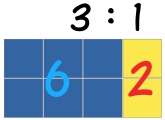
Here the ratio is also 3 blue squares to 1 yellow square,
even though there are more squares.
Using Ratios
The trick with ratios is to always multiply or divide the numbers by the same value.
Example:
| 4 : 5 is the same as 4×2 : 5×2 = 8 : 10 |  |
Recipes
Example: A Recipe for pancakes uses 3 cups of flour and 2 cups of milk.
So the ratio of flour to milk is 3 : 2
To make pancakes for a LOT of people we might need 4 times the quantity, so we multiply the numbers by 4:
3×4 : 2×4 = 12 : 8
In other words, 12 cups of flour and 8 cups of milk.
The ratio is still the same, so the pancakes should be just as yummy.
“Part-to-Part” and “Part-to-Whole” Ratios
The examples so far have been “part-to-part” (comparing one part to another part).
But a ratio can also show a part compared to the whole lot.
Example: There are 5 pups, 2 are boys, and 3 are girls
 |
Part-to-Part:The ratio of boys to girls is 2:3 or 2/3
The ratio of girls to boys is 3:2 or 3/2 Part-to-Whole: The ratio of boys to all pups is 2:5 or 2/5 The ratio of girls to all pups is 3:5 or 3/5
|
Proportions
Proportion says that two ratios (or fractions) are equal.
Example:

So 1-out-of-3 is equal to 2-out-of-6
The ratios are the same, so they are in proportion.
Example: Rope
A ropes length and weight are in proportion.
When 20m of rope weighs 1kg, then:
- 40m of that rope weighs 2kg
- 200m of that rope weighs 10kg
- etc.

So:
201 = 402
Sizes
When shapes are “in proportion” their relative sizes are the same.
| Here we see that the ratios of head length to body length are the same in both drawings.So they are proportional.
Making the head too long or short would look bad! |
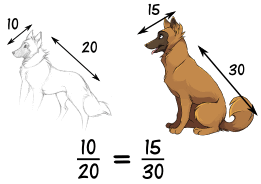 |
Working With Proportions
NOW, how do we use this?
Example: you want to draw the dog’s head, and would like to know how long it should be:
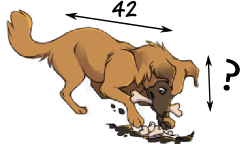
Let us write the proportion with the help of the 10/20 ratio from above:
| ? | = | 10 |
| 42 | 20 |
Now we solve it using a special method:

Multiply across the known corners,
then divide by the third number
And we get this:
? = (42 × 10) / 20 = 420 / 20 = 21
So you should draw the head 21 long.
Using Proportions to Solve Percents
A percent is actually a ratio! Saying “25%” is actually saying “25 per 100”:
| 25% = | 25 |
| 100 |
We can use proportions to solve questions involving percents.
First, put what we know into this form:
| Part | = | Percent |
| Whole | 100 |
Example: what is 25% of 160 ?
The percent is 25, the whole is 160, and we want to find the “part”:
| Part | = | 25 |
| 160 | 100 |
Find the Part:
Example: what is 25% of 160 (continued) ?
| Part | = | 25 |
| 160 | 100 |
Multiply across the known corners, then divide by the third number:

Part = (160 × 25) / 100 = 4000 / 100 = 40
Answer: 25% of 160 is 40.
Note: we could have also solved this by doing the divide first, like this:
Part = 160 × (25 / 100) = 160 × 0.25 = 40
Either method works fine.
We can also find a Percent:
Example: what is $12 as a percent of $80 ?
Fill in what we know:
| $12 | = | Percent |
| $80 | 100 |
Multiply across the known corners, then divide by the third number. This time the known corners are top left and bottom right:

Percent = ($12 × 100) / $80 = 1200 / 80 = 15%
Answer: $12 is 15% of $80
Or find the Whole:
Example: The sale price of a phone was $150, which was only 80% of normal price. What was the normal price?
Fill in what we know:
| $150 | = | 80 |
| Whole | 100 |
Multiply across the known corners, then divide by the third number:

Whole = ($150 × 100) / 80 = 15000 / 80 = 187.50
Answer: the phone’s normal price was $187.50
Using Proportions to Solve Triangles
We can use proportions to solve similar triangles.
Example: How tall is the Tree?
Sam tried using a ladder, tape measure, ropes and various other things, but still couldn’t work out how tall the tree was.
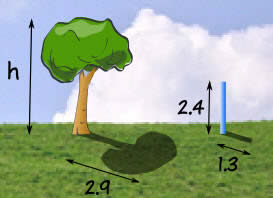
But then Sam has a clever idea … similar triangles!
Sam measures a stick and its shadow (in meters), and also the shadow of the tree, and this is what he gets:
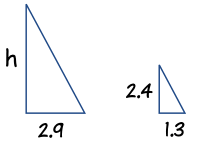
Now Sam makes a sketch of the triangles, and writes down the “Height to Length” ratio for both triangles:
|
h | = | 2.4 m | |||||
| 2.9 m | 1.3 m |
Multiply across the known corners, then divide by the third number:
h = (2.9 × 2.4) / 1.3 = 6.96 / 1.3 = 5.4 m (to nearest 0.1)
Answer: the tree is 5.4 m tall.
And he didn’t even need a ladder!
The “Height” could have been at the bottom, so long as it was on the bottom for BOTH ratios, like this:

Let us try the ratio of “Shadow Length to Height”:
|
2.9 m | = | 1.3 m | |||||
| h | 2.4 m |
Multiply across the known corners, then divide by the third number:
h = (2.9 × 2.4) / 1.3 = 6.96 / 1.3 = 5.4 m (to nearest 0.1)
It is the same calculation as before.
A “Concrete” Example
Ratios can have more than two numbers!
For example concrete is made by mixing cement, sand, stones and water.
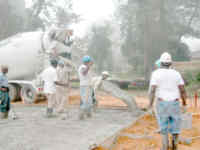
A typical mix of cement, sand and stones is written as a ratio, such as 1:2:6.
We can multiply all values by the same amount and still have the same ratio.
10:20:60 is the same as 1:2:6
So when we use 10 buckets of cement, we should use 20 of sand and 60 of stones.
Example: you have just put 12 buckets of stones into a mixer, how much cement and how much sand should you add to make a 1:2:6 mix?
Let us lay it out in a table to make it clearer:
| Cement | Sand | Stones | |
|---|---|---|---|
| Ratio Needed: | 1 | 2 | 6 |
| You Have: | 12 |
You have 12 buckets of stones but the ratio says 6.
That is OK, you simply have twice as many stones as the number in the ratio … so you need twice as much of everything to keep the ratio.
Here is the solution:
| Cement | Sand | Stones | |
|---|---|---|---|
| Ratio Needed: | 1 | 2 | 6 |
| You Have: | 2 | 4 | 12 |
And the ratio 2:4:12 is the same as 1:2:6 (because they show the same relative sizes)
So the answer is: add 2 buckets of Cement and 4 buckets of Sand. (You will also need water and a lot of stirring….)
Why are they the same ratio? Well, the 1:2:6 ratio says to have:
- twice as much Sand as Cement (1:2:6)
- 6 times as much Stones as Cement (1:2:6)
In our mix we have:
- twice as much Sand as Cement (2:4:12)
- 6 times as much Stones as Cement (2:4:12)
So it should be just right!
That is the good thing about ratios. You can make the amounts bigger or smaller and so long as the relative sizes are the same then the ratio is the same.
To learn more about Ratios and Proportions join our Online Live Math Coaching Classes.
Schedule Your 75 min Free Assessment Today with our Experts !

